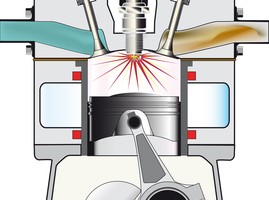About 100 years ago, the motor car changed everything. In a matter of a few years, the motorcar became popularized. Now millions of people use what we now call “cars”. Information almost everyone knows about their car is. When they put gas in the gas tank they can drive and the gas somehow gives power to the wheels to spin and they have an engine that converts gas into power. Karl Benz first created the automobile in 1885 (a three wheeled kart with a small petrol engine). Although Benz created the car, Nikolaus Otto created the engine almost two decades before Benz made the car. Otto created the four stroke engine so many cars run on.
Parts of the Engine
Car engines are built around a set of “cooking pots” called cylinders (usually anything from two to twelve of them, but typically four, six, or eight) inside which the fuel burns. The cylinders are made of super-strong metal and sealed shut, but at one end they open and close like bicycle pumps: they have tight-fitting pistons (plungers) that can slide up and down inside them. At the top of each cylinder, there are two valves (essentially “gates” letting things in or out that can be opened and closed very quickly). The inlet valve allows fuel and air to enter the cylinder from a carburetor or electronic fuel-injector; the outlet valve lets the exhaust gases escape. At the top of the cylinder, there is also a sparking plug (or spark plug), an electrically controlled device that makes a spark to set fire to the fuel. At the bottom of the cylinder, the piston is attached to a constantly turning axle called a crankshaft. The crankshaft powers the car’s gearbox which, in turn, drives the wheels. Whitty’z Houston works on all different makes of car engines!
Steps of Internal Combustion in an engine
- Intake: The piston is pulled down inside the cylinder by the momentum of the crankshaft. Most of the time the car is moving along, so the crankshaft is always turning. The inlet valve opens, letting a mixture of fuel and air into the cylinder through the purple pipe.
- Compression: The inlet valve closes. The piston moves back up the cylinder and compresses (squeezes) the fuel-air mixture, which makes it much more flammable. When the piston reaches the top of the cylinder, the sparking plug fires.
- The spark ignites the fuel-air mixture causing a mini explosion. The fuel burns immediately, giving off hot gas that pushes the piston back down. The energy released by the fuel is now powering the crankshaft.
- The outlet valve opens. As the crankshaft continues to turn, the piston is forced back up the cylinder for a second time. It forces the exhaust gases (produced when the fuel burned) out through the exhaust outlet.
Whitty’z Houston Auto Repair Shop
We are owner operated and customer service oriented. Our goal is to build your trust so we can fix your vehicle and give you a great experience time and time again. We believe in REAL customer service So, at Whitty’z Houston Auto Repair if you call between 8-6 pm Monday- Saturday you will get a conversation and not an answering service. Give us a chance to earn your business and your trust. You deserve quality service and integrity in your Houston auto repair facility. We know that your vehicle is one of your most important possessions and we treat it like our own.





